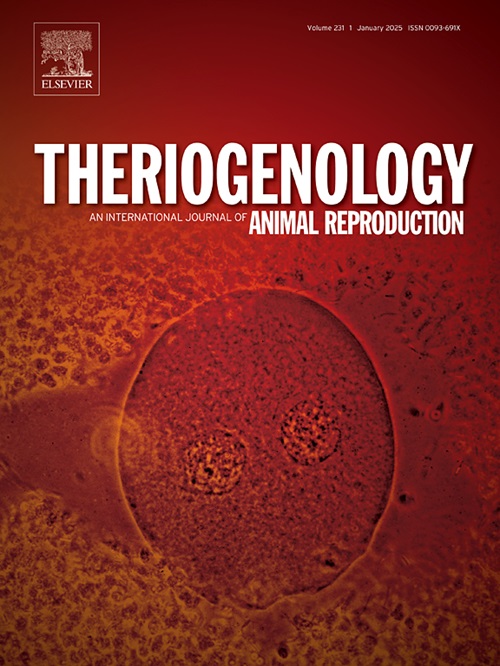自由产母猪及其仔猪血血红蛋白浓度与产犊性能特征和母猪性状相关
IF 2.4
2区 农林科学
Q3 REPRODUCTIVE BIOLOGY
引用次数: 0
摘要
母猪和/或其仔猪的血红蛋白浓度(HbC)可能影响分娩过程。本研究的目的是探讨在自由分娩系统中,母猪和仔猪的HbC与其生产性能特征之间的关系。共纳入103头母猪和1615头仔猪。研究参数包括所有母猪的HbC和每窝约5头仔猪的HbC (n = 496)。此外,还对胎次、窝产仔数、窝重、胎盘重、死胎率、仔猪排出期、产仔期等母猪和仔猪性状进行了评价。母猪平均HbC为106.2±10.36 g/l,窝仔平均HbC为93.6±9.6 g/l。单变量分析显示,HbC和lt为100 g/l(低HbC)的母猪的中位胎次数(5.0,p = 0.003)和产仔数(18,p <;0.001)和胎盘重量(4.9 kg, p <;0.001),与HbC≥100 g/l(高HbC)的母猪相比(3.0;15;3.9公斤)。低HbC母猪中位泌猪持续时间显著更长(290分钟p = 0.005;与高HbC母猪相比(224min)。母猪的HbC与其子代的HbC没有明显的相关性(Pearson相关性:r = 0.124, p = 0.263)。在多变量回归模型中,母猪产前HbC随着产仔数的增加而降低(β = - 0.88),低胎次母猪的HbC比产仔数高6.62 g/l (1 + 2 vs >;2),接受产科干预的母猪血清中胆固醇含量往往高出3.02 g/l。本研究表明,母猪和仔猪的HbC与几个生产性能特征显著相关。它可以作为一个有用的指标,用于分娩管理,有助于改善分娩效果,促进仔猪的健康和活力。本文章由计算机程序翻译,如有差异,请以英文原文为准。
Blood haemoglobin concentrations in free farrowing sows and their piglets are associated with farrowing performance characteristics and sow traits
Haemoglobin concentration (HbC) in sows and/or their piglets might influence the farrowing process. The aim of this study was to investigate the association between the HbC of breeding sows and piglets and their performance characteristics at farrowing in a free farrowing system. In total 103 sows and their 1615 piglets were included. The investigated parameters included the HbC in all sows and the HbC in approximately 5 piglets per litter (n = 496). In addition, parity, litter size, litter weight, placenta weight, stillbirth rate, piglet expulsion duration, farrowing duration and other sow and piglet traits were evaluated. The mean HbC of the sows was 106.2 ± 10.36 g/l and of the litter was 93.6 ± 9.6 g/l. The univariant analysis revealed that sows with a HbC <100 g/l (low HbC) had a significantly higher median parity number (5.0, p = 0.003), litter size (18, p < 0.001) and placenta weight (4.9 kg, p < 0.001) compared to sows with a HbC ≥100 g/l (high HbC) (3.0; 15; 3.9 kg). The median piglet expulsion duration was significantly longer in low HbC sows (290min p = 0.005; compared to high HbC sows (224min). No significant correlation could be determined between the HbC of the sows and the HbC of their offspring (Pearson correlation: r = 0.124, p = 0.263). In the multivariable regression model, pre-partum HbC in sows decreased with an increase in litter size (beta = −0.88), was 6.62 g/l higher in low parity sows (1 + 2 vs > 2) and tended to be 3.02 g/l higher in sows that received obstetrical intervention.
This study showed that the HbC of the sows and the piglets were significantly associated with several performance characteristics. It could serve as a useful indicator in farrowing management, contributing to better farrowing outcomes and promoting improved health and vitality in piglets.
求助全文
通过发布文献求助,成功后即可免费获取论文全文。
去求助
来源期刊

Theriogenology
农林科学-生殖生物学
CiteScore
5.50
自引率
14.30%
发文量
387
审稿时长
72 days
期刊介绍:
Theriogenology provides an international forum for researchers, clinicians, and industry professionals in animal reproductive biology. This acclaimed journal publishes articles on a wide range of topics in reproductive and developmental biology, of domestic mammal, avian, and aquatic species as well as wild species which are the object of veterinary care in research or conservation programs.
 求助内容:
求助内容: 应助结果提醒方式:
应助结果提醒方式:


